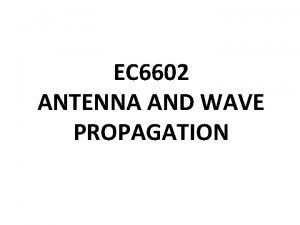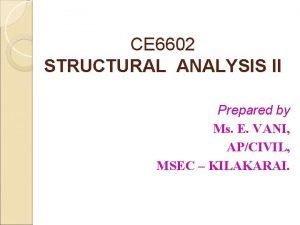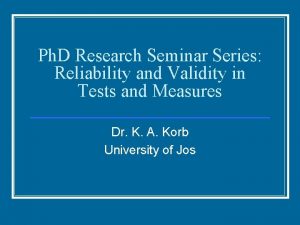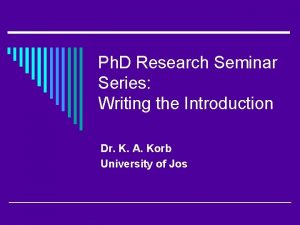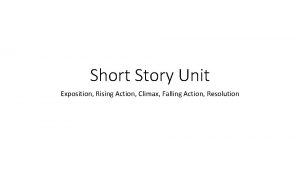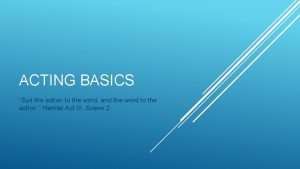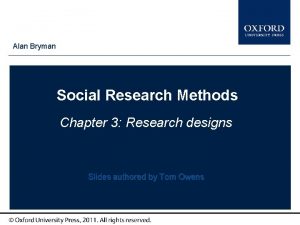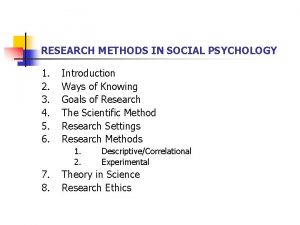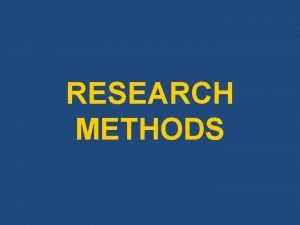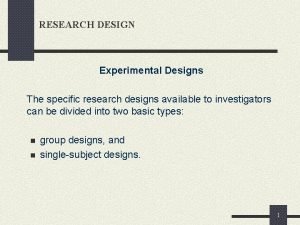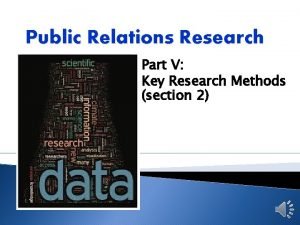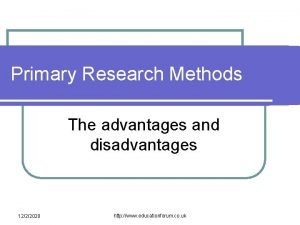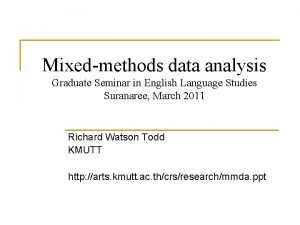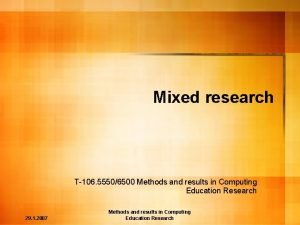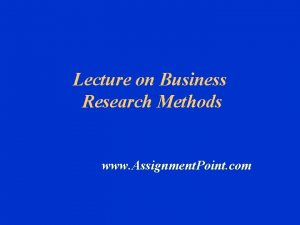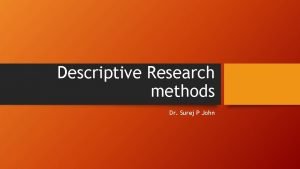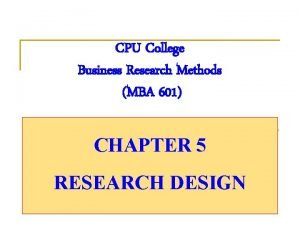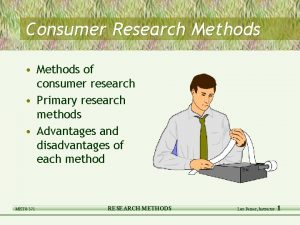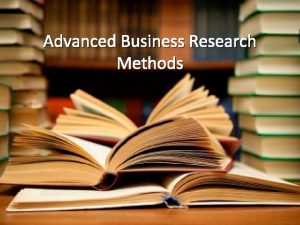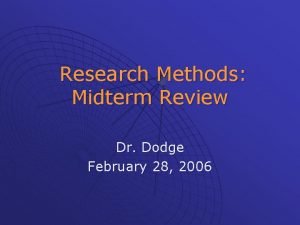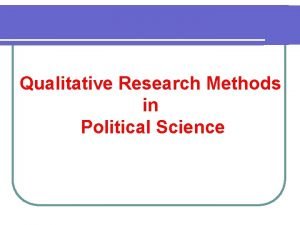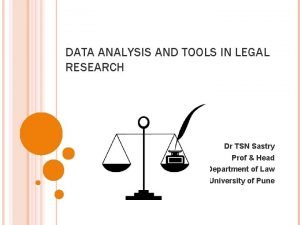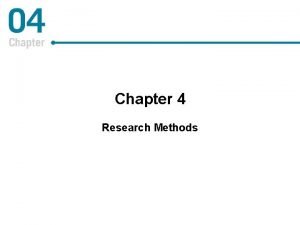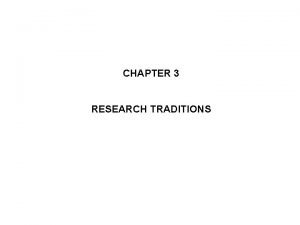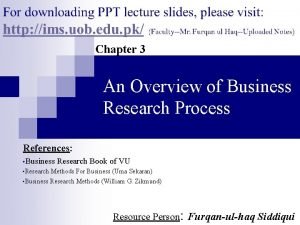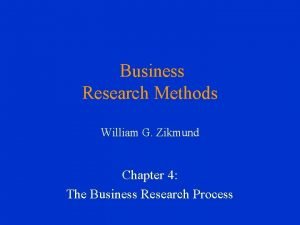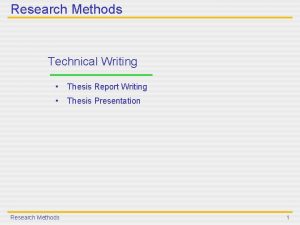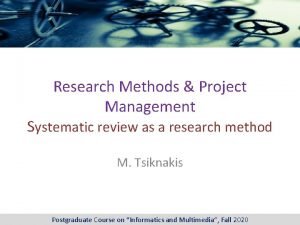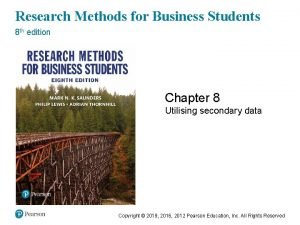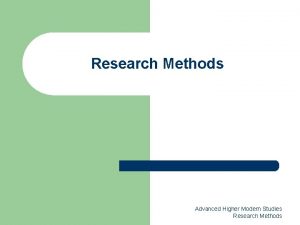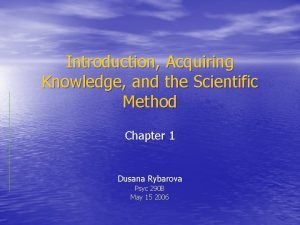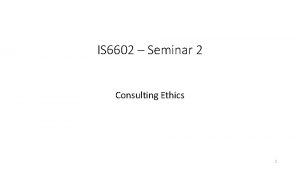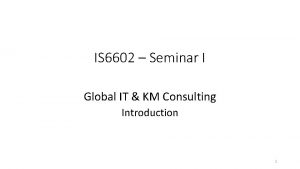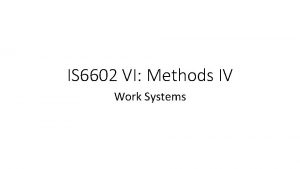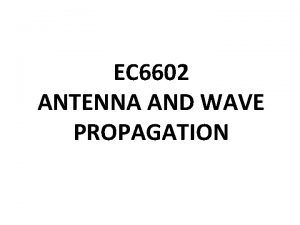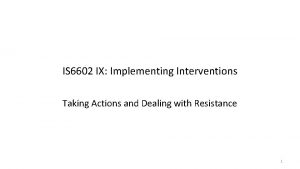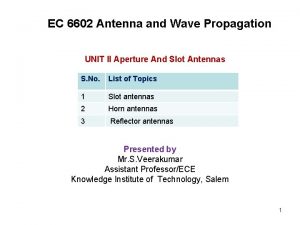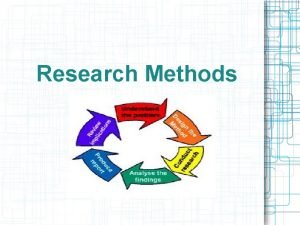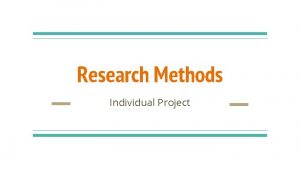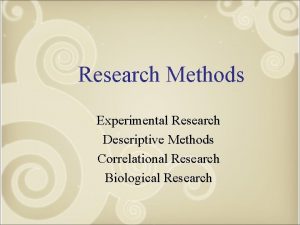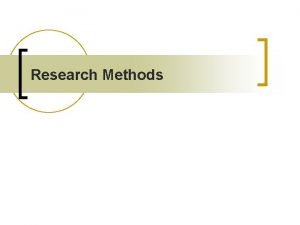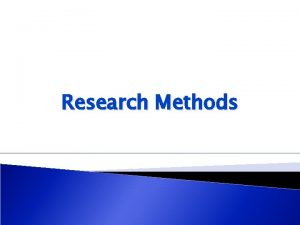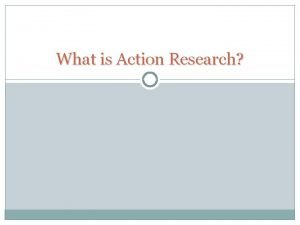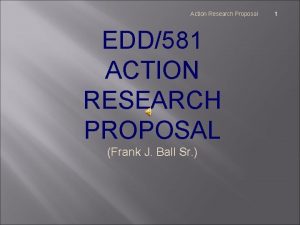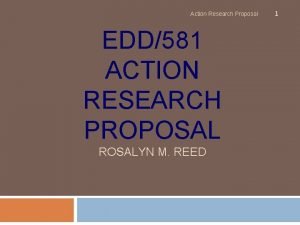IS 6602 Seminar 3 Methods I Action Research









































- Slides: 41

IS 6602 – Seminar 3 Methods I: Action Research 1

Introduction • Action Research (AR) is a method of research and organisational change that is sometimes adopted by consultants • AR is useful for IS 6602 because it facilitates a very structured approach to the activities that consultants undertake • I have used AR in several consulting projects in different industry sectors • AR is very similar in general principles/structure to the proprietary consulting methods used by Mc. Kinsey, PWC etc. 2

Origins • AR was developed in the mid-1940 s by Kurt Lewin and focused on a three-stage process: 1) Unfreezing, 2) Changing and 3) Refreezing 1. The existing mind-set has to be dismantled 2. The old is replaced with something new 3. The new mind-set is frozen into place and an equilibrium is restored • Lewin also argued that only through experience can people really change 3

Lewin, AR and Consulting • Lewin’s contributions to knowledge are important for consultants, who must: – Work with clients to help them understand the nature of a problem • This involves rationalization – making sense – Provide a change process that addresses the problem – Help clients to accept the new mind-set that is created • This involves institutionalization – ensuring that everyone buys in to the solutions • The client experience is central to consulting practice – Happy Clients = Success 4

Later Developments • In 1978, Roger Susman and Gerard Evered proposed a new model for AR • They expanded the three stage model to five, which operates in a cyclical fashion – 1) Diagnosis, 2) Action Planning, 3) Action Taking, 4) Evaluation, 5) Reflection • In addition to this formal structure, there is a need for a formal agreement between the consultant and the client 5

Modified 1978 Model Consultant-Client Agreement 6

AR Definition • Action Research involves… – solving organisational problems – improving organisational circumstances for all stakeholders (employees, managers, customers) • … by means of consultant intervention, thus… – contributing to knowledge about method, theory & organisational practice 7

AR Characteristics • Iterative – One or more cycles of interventions is normal • Rigorous – Carefully planned iterations to develop detailed problem context knowledge and to identify relevant solutions – Continuous problem (re)diagnosis – Flexible application of the method • Collaborative – Consultants and Clients must work together – Clients must actively participate in the project 8

AR and Clients • As a method, AR has seen application by both researchers (academics) and consultants • AR requires the application of theory • Clients may not care about theory; all they want is a solution to an organisational problem • Consultants and clients need to work together collaboratively, which can be a huge challenge for both parties – They need to listen, to discuss, to reflect 9

AR and Theory • A theory is a plausible body of principles offered to explain phenomena – – Theory of Planned Behaviour Punctuated Equilibrium theory Shifting Baseline Theory Work Systems Theory • The purpose of a theory is “to describe and explain how things actually work” (Lyneham, 2002) 10

AR and Theory Application • We use theories to – organise and make sense of phenomena – explain and predict human behaviour – focus on the most fundamental ideas, showing the relationships between these ideas – provide a consistent set of concepts and principles that we can compare with reality • Theories are useful if they guide and structure the design of a project • Theories may need to be adapted to a specific context 11

Which Theories Do You Know? • They don’t have to be academic theories • But they do need to help you make sense of something • They might describe your successful behaviour in a particular domain • You might not think that they are theories at all; perhaps you call them models, techniques, heuristics? – But whatever you call them, they should be ‘things’ that you can consistently apply to a situation so as to achieve predictable outcomes 12

AR, the Organisation and Change • An AR project can be expected to investigate the evolution of an organisational change process in detail • Each organisational context will have a unique set of constraints and idiosyncrasies • Organisations are not static objects: – You can’t plan everything in advance – There is an infinite variety of circumstances to which you must adapt! – A plan is useful, but must also be flexible as the situation changes 13

The Need for Guidelines • Any method needs guidelines if it is to be used consistently and correctly • Consultants need to know what they are doing and how to do it well, so as to ensure: – Consistency when applying the method – Plans and interventions are rigorous (methodologically correct) and relevant (useful, consumable, readable, meaningful and value adding to the client) 14

Improving AR as a Method • AR has been applied quite extensively in the last 35 years, but before 2000 there were no detailed ‘how to do AR’ guidelines • Based on our experience, we wrote up such a set of guidelines in two papers; a 3 rd paper is in progress. • These guidelines were designed to be helpful, but not deterministic. • These guidelines were originally written for researchers, but I adapt them here for consultants 15

Principles of AR (2004) • In our first paper, we developed a set of five principles and 31 criteria that were designed to: – apply to most AR situations – be interdependent yet flexible – facilitate • • clear/systematic presentation of findings, justification of courses of action, explicit contributions to knowledge an assessment of how well the AR was done 16

Modified 1978/2004 Model Consultant-Client Agreement 17

Theory & AR (2012) • In our second paper, we revised some criteria, added others and focused in particular on the role of theory • We identified two different types of theory – instrumental – focal • and documented how each contributes to making AR better. 18

New Cyclical Process Model (2012) Project End Project Start Diagnosis Action Planning Reflection Instrumental Theory Focal Theories Consultant-Client Agreement Evaluation Intervention 19

Principles & Criteria 1. 2. 3. 4. 5. Consultant-Client Agreement Cyclical Process Model Role of Theory Change through Action Specification of Learning 20

1. Consultant-Client Agreement • Guiding foundation for the project • Client must understand what CAR involves • Mutual guarantees for behaviour, including an NDA and consultant rights • Basis for building trust in the organisational context • Promote a spirit of shared inquiry, such that the client accepts the principle of collaboration and the consultant gains access to resources 21

CCA Criteria a. Did both the consultant and the client agree that AR was the appropriate method for the organisational situation? b. Was the focus of the project specified clearly and explicitly? c. Did the client make an explicit commitment to the project? d. Were the roles and responsibilities of the consultant and client stakeholders specified explicitly? e. Were project objectives and evaluation measures specified explicitly? f. Were the data collection and analysis methods specified explicitly? 22

2. Cyclical Process Model • Sequential progress through the Cyclical Process Model helps to ensure rigour • Some between-stage iteration may occur, but it needs to be justified • Usually several cycles are necessary – It is rare that a problem can be fixed quickly – Considerable time and energy, from many people, are required 23

CPM Criteria a. Did the project follow the cyclical process model or justify any deviation from it? b. Did the consultant conduct an independent diagnosis of the organisational situation? c. Were the planned actions based explicitly on the results of the diagnosis? d. Were the planned actions implemented and evaluated? e. Did the consultant reflect on the outcomes of the intervention? f. Was this reflection followed by an explicit decision on whether or not to proceed through an additional process cycle? 24

CPM Criteria g. Were both the exit of the consultant and the conclusion of the project due to either the project objectives being met or some other clearly articulated justification? h. How was the independent diagnosis of the organisational situation conducted? i. Which instrumental theories did the consultant use? j. How were these theories selected? k. How did these theories support the identification of the focal theory used to guide the changes? l. Post-intervention, did the consultant reflect on the instrumental theories used and their suitability? 25

3. Theory • Theory is a central component of Action Research • Theory can help the consultant to analyse a situation, to ask the right questions and then to plan the changes • However, it is highly unlikely that a consultant will know definitely and in advance the exact theory that will be used • So the consultant may need to engage in theory-free problem diagnosis at the start of a project 26

Theory • Lewin (1945): “There is nothing so practical as a good theory” • Ghoshal (2005): “Nothing is as dangerous as a bad theory” – Both of these two statements apply equally to AR – Selection of an appropriate theory must be handled with great care given the potential for negative consequences in the organisational setting. 27

Instrumental Theory • Instrumental theories – Help us to “organize our thoughts, generate coherent explanations … [and so] achieve understanding” (Hambrick, 2007). – Will be practical (Lewin 1945) and closely match reality (cf. Weick 1995). • Instrumental theories are particularly valuable for diagnosis and planning • They play a mediating role between client and researcher • They are used to explain and analyse organisational activities related to the project/problem • They include any tools, models or processes that help us to make sense of how work is done or how outcomes are achieved. 28

Examples of Instrumental Theories • • • Balanced Scorecard Value Shop, Value Chain, Business Process Models Porter’s Five Forces Analysis SWOT and PEST Work Systems Theory • Any model or theory that can be applied to an organisational situation so as to make sense of what people do 29

Focal Theory • Provides the intellectual basis for action-oriented change in a CAR project. • Is unlikely to remedy an organisational problem alone; must be in combination with one or more instrumental theories • Must be aligned to the precise organisational circumstances • Good examples of general purpose focal theories are: – – Theory of Planned Behaviour Technology Adoption Model Punctuated Equilibrium Theory Transactive Memory Theory 30

PET: Punctuated Equilibrium Theory • Unlike theories of steady but slow incremental change, PET suggests that change takes place in revolutionary bursts, triggered by significant environmental changes that break apart a system’s deep structures – Technological innovation can be one such environmental change • Killer IT innovations can be seen as examples of these punctuations 31

TMT: Transactive Memory Theory • Individual people can serve as external memory aids to each other (Wegner, 1986) • Members of a Transactive Memory (TM) System (TMS) can benefit from each other’s knowledge and expertise if they develop a good, shared understanding (meta-memory) of who knows what. • TMS enable better use of knowledge held by members and so higher performance 32

Indigenous Theory • Sometimes it may be that you cannot find any theory that adequately maps onto a specific organisational situation and gives you guidance about what kinds of action to follow • You may need to develop your own theory, perhaps after the intervention is completed, in order to explain better what happened • Do Western theories make sense in China? – Are there local constructs, concepts, ways of thinking that are not represented in the Western theories, yet which are critical to local behaviour? 33

Theory & Consequences • What might go wrong if we pick an inappropriate theory? – We could push the organisation to change in a direction that does not fit its organisational culture, leading to internal conflicts, or worse. • We need to choose a theory that fits the organisational circumstances, the IT, the people, the culture. – The client needs to approve theory. 34

Theory Criteria a. Were the project activities guided by a theory or set of theories? b. Was the domain of investigation, and the specific problem setting, relevant and significant to the interests of the consultant as well as the client? c. Was an instrumental theory used to derive the causes of the observed problem? d. Did the planned intervention follow from this instrumental theory? e. Was the focal theory used to evaluate the outcomes of the intervention? 35

Theory Criteria f. Did a focal theory emerge from the situation or during the problem diagnosis? g. Was this focal theory acceptable to both client and consultant? h. What role did instrumental and focal theories play with respect to the diagnosis and the action planning? i. Were these theories evaluated for their applicability to the organisational context, considering current organisational practices? j. Did both the consultant and the client undertake this evaluation? k. Were theoretical explanations for the current organisational problem situation evaluated and reflected upon? l. Did the consultant reflect on the focal theory used and its ability to predict the change outcomes? 36

4. Change through Action • Action and change are indivisible • If there is no change… – No problem, intervention failed, or obstacles prevent successful intervention • Both consultant and client must be motivated to design and implement change • The change needs to be contextually and culturally appropriate 37

Change through Action Criteria a. Were both the consultant and the client motivated to improve the situation? b. Were the problem and its hypothesized cause(s) specified as a result of the diagnosis? c. Were the planned actions designed to address the hypothesized cause(s)? d. Did the client approve the planned actions before they were implemented? e. Was the organisation situation assessed comprehensively both before and after the intervention? f. Were the timing and nature of the actions taken clearly and completely documented? 38

5. Learning through Reflection • After the intervention is complete, the consultant and the client need to reflect on progress • Did the practical solutions work? – If not, why not? What else could be done? • Were theory and the method appropriate? • What else was learned that can inform either future interventions in the current project or future projects? 39

Learning through Reflection Criteria a. Did the consultant provide progress reports to the client? b. Did both the consultant and the client reflect upon the outcomes of the project? c. Were the research activities and outcomes reported clearly and completely? d. Were the results considered in terms of implications for further action in this situation? e. Were the results considered in terms of implications for action to be taken in related research domains? f. Were the results considered in terms of implications for the consulting community? g. Were the results considered in terms of the general applicability of AR as a method? 40

Conclusions • AR is a very practical and flexible method • It provides a framework for consultants to apply to different situations and explains how theory can help • It provides many criteria (questions) that push the consultant to engage in different activities • It does not go into the precise details of how the client’s needs can be diagnosed: we will look at this next week. 41
 Characters back
Characters back Ce6602 structural analysis 2
Ce6602 structural analysis 2 Radiation intensity of antenna
Radiation intensity of antenna Metal coping fpd
Metal coping fpd Validity in psychology
Validity in psychology Operational definition of independent variable
Operational definition of independent variable What is the organized sequence of events called in a story?
What is the organized sequence of events called in a story? Climax of the lion and the mouse
Climax of the lion and the mouse 5 plot stages
5 plot stages Exposition in a rose for emily
Exposition in a rose for emily Suit the action to the word the word to the action meaning
Suit the action to the word the word to the action meaning Alan bryman social research methods
Alan bryman social research methods Research methods notes
Research methods notes Method of social psychology
Method of social psychology Research methods in developmental psychology
Research methods in developmental psychology Time dimension of the study example
Time dimension of the study example Research design example
Research design example Public relations research methods
Public relations research methods Primary research advantages and disadvantages
Primary research advantages and disadvantages Examples of quantitative research questions and hypotheses
Examples of quantitative research questions and hypotheses Mixed methods research examples
Mixed methods research examples Business research methods assignment
Business research methods assignment Conceptual framework for descriptive research
Conceptual framework for descriptive research Business research methods mba
Business research methods mba Types of consumer research methods
Types of consumer research methods Method
Method Advanced business research
Advanced business research Midterm exam for applied research methods
Midterm exam for applied research methods Qualitative analysis political science
Qualitative analysis political science Slidetodoc. com
Slidetodoc. com Legal research tools and techniques
Legal research tools and techniques Research methods in abnormal psychology
Research methods in abnormal psychology Ontology vs epistemology vs methodology
Ontology vs epistemology vs methodology Business research process design
Business research process design Business research methods zikmund
Business research methods zikmund Technical background in research
Technical background in research Expected results research proposal example
Expected results research proposal example Research methods in project management
Research methods in project management Secondary data advantages
Secondary data advantages Advanced higher modern studies essay structure
Advanced higher modern studies essay structure Research qualitative or quantitative
Research qualitative or quantitative What are the different methods of acquiring knowledge
What are the different methods of acquiring knowledge
